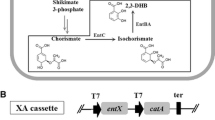Abstract
Objectives
To achieve biosynthesis of caffeoylmalic acid from glucose in engineered Escherichia coli.
Results
We constructed the biosynthetic pathway of caffeoylmalic acid in E. coli by co-expression of heterologous genes RgTAL, HpaBC, At4CL2 and HCT2. To enhance the production of caffeoylmalic acid, we optimized the tyrosine metabolic pathway of E. coli to increase the supply of the substrate caffeic acid. Consequently, an E. coli–E. coli co-culture system was used for the efficient production of caffeoylmalic acid. The final titer of caffeoylmalic acid reached 570.1 mg/L.
Conclusions
Microbial production of caffeoylmalic acid using glucose has application potential. In addition, microbial co-culture is an efficient tool for producing caffeic acid esters.




Similar content being viewed by others
References
Bonetti G, Tedeschi P, Meca G, Bertelli D, Manes J, Brandolini V, Maietti A (2016) In vitro bioaccessibility, transepithelial transport and antioxidant activity of Urtica dioica l. Phenolic compounds in nettle-based food products. Food Funct 7(10):4222–4230
Carvalho AR, Costa G, Figueirinha A, Liberal J, Prior JAV, Lopes MC, Cruz MT, Batista MT (2017) Urtica spp.: Phenolic composition, safety, antioxidant and anti-inflammatory activities. Food Res Int 99(1):485–494
Chen Z, Sun X, Li Y, Yan Y, Yuan Q (2017) Metabolic engineering of Escherichia coli for microbial synthesis of monolignols. Metab Eng 39:102–109
Ehlting J, Buttner D, Wang Q, Douglas CJ, Somssich IE, Kombrink E (1999) Three 4-coumarate: coenzyme a ligase in Arabidopsis thaliana represent two evolutionarily divergent classes in angiosperms. Plant J Cell Mol Biol 19(1):9–20
Eudes A, Juminaga D, Baidoo EE, Collins FW, Keasling JD, Loque D (2013) Production of hydroxycinnamoyl anthranilates from glucose in Escherichia coli. Microb Cell Fact 12:62
Eudes A, Mouille M, Robinson DS, Benites VT, Wang G, Roux L, Tsai YL, Baidoo EE, Chiu TY, Heazlewood JL, Scheller HV, Mukhopadhyay A, Keasling JD, Deutsch S, Loque D (2016) Exploiting members of the BAHD acyltransferase family to synthesize multiple hydroxycinnamate and benzoate conjugates in yeast. Microb Cell Fact 15(1):198
Fattahi S, Ardekani AM, Zabihi E, Abedian Z, Mostafazadeh A, Pourbagher R, Akhavan-Niaki H (2013) Antioxidant and apoptotic effects of an aqueous extract of Urtica dioica on the MCF-7 human breast cancer cell line. Asian Pac J Cancer Prev 14(9):5317–5323
Huang Q, Lin Y, Yan YJ (2013) Caffeic acid production enhancement by engineering a phenylalanine over-producing Escherichia coli strain. Biotechnol Bioeng 110(12):3188–3196
Jones JA, Vernacchio VR, Sinkoe AL, Collins SM, Ibrahim MHA, Lachance DM, Hahn J, Koffas MA (2016) Experimental and computational optimization of an Escherichia coli co-culture for the efficient production of flavonoids. Metab Eng 35:55–63
Katsuyama Y, Miyahisa I, Funa N, Horinouchi S (2007) One-pot synthesis of genistein from tyrosine by co-incubation of genetically engineered Escherichia coli and Saccharomyces cerevisiae cells. Appl Microbiol Biotechnol 73(5):1143–1149
Lin Y, Sun X, Yuan Q, Yan Y (2013) Combinatorial biosynthesis of plant-specific coumarins in bacteria. Metab Eng 18:69–77
Matejczyk M, Åwis£ocka R, Kalinowska M, Åwiderski G, Lewandowski W (2017) Monitoring of synergistic enhancement of caffeic acid on Escherichia coli K-12 RECA: GFP strain treated with dacarbazine. Acta Pol Pharm 74(3):809–816
Robert H, Adolf N (1993) Hydroxycinnamic acid derivatives, caffeoylmalic and new caffeoylaldonic acid esters, from Chelidonium majus*,1. Planta Med 59(1):71–75
Sullivan M (2009) A novel red clover hydroxycinnamoyl transferase has enzymatic activities consistent with a role in phaselic acid biosynthesis. Plant Physiol 150(4):1866–1879
Sullivan ML, Zarnowski R (2011) Red clover HCT2, a hydroxycinnamoyl-coenzyme a: malate hydroxycinnamoyl transferase, plays a crucial role in biosynthesis of phaselic acid and other hydroxycinnamoyl-malate esters in vivo. Plant Physiol 155(3):1060–1067
Sullivan ML, Zeller WE (2013) Efficacy of various naturally occurring caffeic acid derivatives in preventing post-harvest protein losses in forages. J Sci Food Agric 93(2):219–226
Wang T, Jiao J, Gai QY, Wang P, Gao N, Niu LL, Fu YJ (2017) Enhanced and green extraction polyphenols and furanocoumarins from Fig (Ficus carica L.) leaves using deep eutectic solvents. J Pharm Biomed Anal 145(2017):339–345
Wanner BL, Datsenko KA (2000) One-step inactivation of chromosomal genes in Escherichia coli K-12 using PCR products. Proc Natl Acad Sci USA 97(12):6640–6645
Watts KT, Mijts BN, Lee PC, Manning AJ, Schmidt-Dannert C (2006) Discovery of a substrate selectivity switch in tyrosine ammonia-lyase, a member of the aromatic amino acid lyase family. Chem Biol 13(12):1317–1326
Zhuang Y, Jiang J, Bi H, Yin H, Liu S, Liu T (2016) Synthesis of rosmarinic acid analogues in Escherichia coli. Biotechnol Lett 38(4):619–627
Acknowledgement
This work was supported by grants from the National Natural Science Foundation of China (Nos. 31770104, 21302214), the Key Deployment Project of CAS (No. KFZD-SW-215) and the Youth Innovation Promotion Association CAS (2017207).
Supporting information
Supplementary Table 1—Plasmids and strains used in this study.
Supplementary Table 2—Primers used in this study.
Supplementary Fig. 1—HPLC analysis of the production of p-coumaric acid in strains BW01 and BW02.
Supplementary Fig. 2—HPLC analysis of the production of caffeic acid in strains BW03 and BTAL01
Supplementary Fig. 3—Comparation of the production of p-coumaric acid and caffeic acid in E. coli BL21 (DE3).
Supplementary Fig. 4—1H and 13C NMR spectrum of isolated caffeoylmalic acid in CD3OD.
Supplementary Fig. 5—Time profile of cell growth of BTAL01 and BTAL02.
Supplementary Fig. 6—E. coli–E. coli co-culture system for efficient production of caffeoylmalic acid.
Supplementary Fig. 7—HPLC analysis of the products in the fermentation supernatant of the co-cultures with the inoculum ratio of 6:1.
Supplementary Fig. 8—Time profiles of cell growth of the co-culture system.
Author information
Authors and Affiliations
Corresponding author
Electronic supplementary material
Below is the link to the electronic supplementary material.
Rights and permissions
About this article
Cite this article
Li, T., Zhou, W., Bi, H. et al. Production of caffeoylmalic acid from glucose in engineered Escherichia coli. Biotechnol Lett 40, 1057–1065 (2018). https://doi.org/10.1007/s10529-018-2580-x
Received:
Accepted:
Published:
Issue Date:
DOI: https://doi.org/10.1007/s10529-018-2580-x




